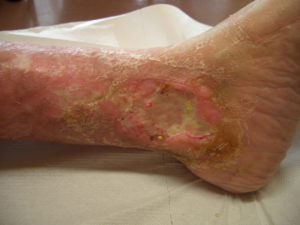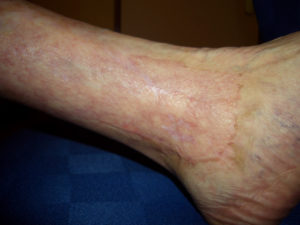Recalcitrant ulcers in the ambulant patient are those which do not heal after all the conventional treatments have been exhausted. These include the abolition of reflux sources and the diligent use of compression bandaging. In these cases there are two invasive options: shaving and fasciectomy. Shaving involves tangential paring of the ulcer down to fresh healthy tissue followed by skin grafting. This is akin to the action of a kebab knife shaving strips from the rotating donor meat. Fasciectomy involves the partial excision of the scar tissue constricting the gaiter region. This release operation allows better perfusion and healing of the ulcer.
DOMINIK HEIM In Thun (Venenzentrum Thun) we perform shaving regularly. It is the ultimate, most invasive and best treatment for recalcitrant venous leg ulcers. The ultimate because it is often performed as the last option in long lasting ulcers, having tried several non-effective and inappropriate surgical procedures. The most invasive because it is bloody, though not very demanding surgery. It requires a hospital stay for about 2-3 weeks. It is the best because the long term results are better than those of all other surgical techniques.
The principle is to shave off the ulcer until bleeding points are apparent all over the ulcer base. A split skin graft is then taken from the thigh and placed onto the raw area during the same procedure. The interstices of the split skin prevent the graft from lifting by allowing the escape of blood and tissue fluid. Chronic scarred ulcers are very poor surfaces for grafting. Shaving removes the scaring and converts a chronic ulcer into a fresh acute wound. There is no need to wait for the development of granulation tissue. The graft will stick immediately.
Postoperatively, the graft donor site is treated with daily dressings using medical honey. The first change of dressing of the grafted site is after one week. This must be followed by meticulous personal care, foot hygiene, physiotherapy, elevation drainage and compression.
Female, 90 years old, ulcer for 5 years on the medial aspect of the lower part of the left leg
Same patient, result at 2 years

